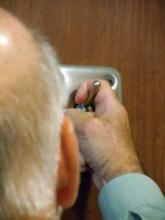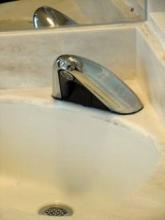User login
CHICAGO – A new 29-bed inpatient psychiatric care facility at Northwestern Memorial Hospital’s Stone Institute of Psychiatry was designed with two key elements in mind: the on-stage, off-stage concept, also known as the "Disney concept," and the idea of a treatment mall, said registered nurse Maureen Slade. Above all, the designers wanted patients to feel safe and comfortable, as in a neighborhood.
"You can have that philosophy in your head, but if you don’t have a facility that supports that, it’s very hard to actualize the concept," said Ms. Slade, who worked actively on the facility’s design.
The new unit, known as Galter 13 because it is on the 13th floor of the hospital’s Galter Pavilion, is scheduled to open Sept. 24, but was recently previewed in a seminar at the hospital titled "Reinventing Inpatient Psychiatry." The unit includes patient rooms, a day room, group rooms, a gym, a dining room, a meditation/comfort room, and nursing stations.
Patient care occurs in the "on-stage" area, which is available only to those directly caring for or supporting patients. These might include consulting physicians, nursing staff, and environmental services, but not support personnel like pharmacy or materials management. The latter functions will be kept out of sight to maintain patients’ privacy.
Interview rooms allow family, significant others, or outside therapists to meet the staff without having the patient present, or for that matter ever entering the patient’s care space.
Therapeutic groups, structured activities, and community dining occur in one of four areas known as the "treatment mall": the dining room, group room, occupational therapy room, and gym. Programming in the mall occurs all day and into the evening, from 8 a.m. to 9 p.m.
Northwestern hopes that Galter 13’s novel design will create a sense of community, shelter, and comfort that models life: Patient rooms are to be considered home, the day room is the neighborhood, and the treatment mall is to be thought of as "working downtown."
Large glass picture windows protectively sheathed in unbreakable Lexan provide the entire space with ample daylight.
"We want the patients ... to come out of their rooms and engage," Ms. Slade said. She hopes the unit’s many offerings will help patients develop skills in self-management.
Technology also is used to enhance care. All group rooms and the meditation/comfort room have monitors for educational DVDs. Special lighting features like atmospheric ceilings change color and brightness with the time of day or night to support the patients’ circadian rhythms.
The small but comfortable meditation/comfort room exists to supply a single patient with a quiet, healing space where even lighting can be individualized in both color and brightness. The room is equipped with various other soothing nuances, including aromatherapy and weighted blankets.
Advanced call and communication systems are made available to the staff.
The facility supports best practices, said Ms. Slade, including expert psychopharmacology, empowering communications like cognitive-behavioral therapy and behavioral activation, and neuromodulation, including transcranial magnetic stimulation, electroconvulsive treatment, and deep brain stimulation.
Most of the patient’s rooms are private, and all are uncluttered and designed for safety. Mirrors are not glass, hinges run the full length of doors, and all fixtures are either encased or are otherwise ligature-resistant. The unit also contains Stryker psychiatric beds without side rails, though patients deemed medically compromised get acute care beds.
"We’re pretty obsessed with safety and security ... we want zero suicides in our unit," Ms. Slade said.
Ms. Slade disclosed no conflicts of interest.
CHICAGO – A new 29-bed inpatient psychiatric care facility at Northwestern Memorial Hospital’s Stone Institute of Psychiatry was designed with two key elements in mind: the on-stage, off-stage concept, also known as the "Disney concept," and the idea of a treatment mall, said registered nurse Maureen Slade. Above all, the designers wanted patients to feel safe and comfortable, as in a neighborhood.
"You can have that philosophy in your head, but if you don’t have a facility that supports that, it’s very hard to actualize the concept," said Ms. Slade, who worked actively on the facility’s design.
The new unit, known as Galter 13 because it is on the 13th floor of the hospital’s Galter Pavilion, is scheduled to open Sept. 24, but was recently previewed in a seminar at the hospital titled "Reinventing Inpatient Psychiatry." The unit includes patient rooms, a day room, group rooms, a gym, a dining room, a meditation/comfort room, and nursing stations.
Patient care occurs in the "on-stage" area, which is available only to those directly caring for or supporting patients. These might include consulting physicians, nursing staff, and environmental services, but not support personnel like pharmacy or materials management. The latter functions will be kept out of sight to maintain patients’ privacy.
Interview rooms allow family, significant others, or outside therapists to meet the staff without having the patient present, or for that matter ever entering the patient’s care space.
Therapeutic groups, structured activities, and community dining occur in one of four areas known as the "treatment mall": the dining room, group room, occupational therapy room, and gym. Programming in the mall occurs all day and into the evening, from 8 a.m. to 9 p.m.
Northwestern hopes that Galter 13’s novel design will create a sense of community, shelter, and comfort that models life: Patient rooms are to be considered home, the day room is the neighborhood, and the treatment mall is to be thought of as "working downtown."
Large glass picture windows protectively sheathed in unbreakable Lexan provide the entire space with ample daylight.
"We want the patients ... to come out of their rooms and engage," Ms. Slade said. She hopes the unit’s many offerings will help patients develop skills in self-management.
Technology also is used to enhance care. All group rooms and the meditation/comfort room have monitors for educational DVDs. Special lighting features like atmospheric ceilings change color and brightness with the time of day or night to support the patients’ circadian rhythms.
The small but comfortable meditation/comfort room exists to supply a single patient with a quiet, healing space where even lighting can be individualized in both color and brightness. The room is equipped with various other soothing nuances, including aromatherapy and weighted blankets.
Advanced call and communication systems are made available to the staff.
The facility supports best practices, said Ms. Slade, including expert psychopharmacology, empowering communications like cognitive-behavioral therapy and behavioral activation, and neuromodulation, including transcranial magnetic stimulation, electroconvulsive treatment, and deep brain stimulation.
Most of the patient’s rooms are private, and all are uncluttered and designed for safety. Mirrors are not glass, hinges run the full length of doors, and all fixtures are either encased or are otherwise ligature-resistant. The unit also contains Stryker psychiatric beds without side rails, though patients deemed medically compromised get acute care beds.
"We’re pretty obsessed with safety and security ... we want zero suicides in our unit," Ms. Slade said.
Ms. Slade disclosed no conflicts of interest.
CHICAGO – A new 29-bed inpatient psychiatric care facility at Northwestern Memorial Hospital’s Stone Institute of Psychiatry was designed with two key elements in mind: the on-stage, off-stage concept, also known as the "Disney concept," and the idea of a treatment mall, said registered nurse Maureen Slade. Above all, the designers wanted patients to feel safe and comfortable, as in a neighborhood.
"You can have that philosophy in your head, but if you don’t have a facility that supports that, it’s very hard to actualize the concept," said Ms. Slade, who worked actively on the facility’s design.
The new unit, known as Galter 13 because it is on the 13th floor of the hospital’s Galter Pavilion, is scheduled to open Sept. 24, but was recently previewed in a seminar at the hospital titled "Reinventing Inpatient Psychiatry." The unit includes patient rooms, a day room, group rooms, a gym, a dining room, a meditation/comfort room, and nursing stations.
Patient care occurs in the "on-stage" area, which is available only to those directly caring for or supporting patients. These might include consulting physicians, nursing staff, and environmental services, but not support personnel like pharmacy or materials management. The latter functions will be kept out of sight to maintain patients’ privacy.
Interview rooms allow family, significant others, or outside therapists to meet the staff without having the patient present, or for that matter ever entering the patient’s care space.
Therapeutic groups, structured activities, and community dining occur in one of four areas known as the "treatment mall": the dining room, group room, occupational therapy room, and gym. Programming in the mall occurs all day and into the evening, from 8 a.m. to 9 p.m.
Northwestern hopes that Galter 13’s novel design will create a sense of community, shelter, and comfort that models life: Patient rooms are to be considered home, the day room is the neighborhood, and the treatment mall is to be thought of as "working downtown."
Large glass picture windows protectively sheathed in unbreakable Lexan provide the entire space with ample daylight.
"We want the patients ... to come out of their rooms and engage," Ms. Slade said. She hopes the unit’s many offerings will help patients develop skills in self-management.
Technology also is used to enhance care. All group rooms and the meditation/comfort room have monitors for educational DVDs. Special lighting features like atmospheric ceilings change color and brightness with the time of day or night to support the patients’ circadian rhythms.
The small but comfortable meditation/comfort room exists to supply a single patient with a quiet, healing space where even lighting can be individualized in both color and brightness. The room is equipped with various other soothing nuances, including aromatherapy and weighted blankets.
Advanced call and communication systems are made available to the staff.
The facility supports best practices, said Ms. Slade, including expert psychopharmacology, empowering communications like cognitive-behavioral therapy and behavioral activation, and neuromodulation, including transcranial magnetic stimulation, electroconvulsive treatment, and deep brain stimulation.
Most of the patient’s rooms are private, and all are uncluttered and designed for safety. Mirrors are not glass, hinges run the full length of doors, and all fixtures are either encased or are otherwise ligature-resistant. The unit also contains Stryker psychiatric beds without side rails, though patients deemed medically compromised get acute care beds.
"We’re pretty obsessed with safety and security ... we want zero suicides in our unit," Ms. Slade said.
Ms. Slade disclosed no conflicts of interest.
EXPERT ANALYSIS FROM A SEMINAR ON "REINVENTING INPATIENT PSYCHIATRY"

